In previous posts on Hell’s Printing Press, I have explored the process of illustration markup and textual tagging at the WBA (see my earlier posts about textual tagging broadly and focused studies of tags like “streams of gore,” “lunging,” and “ecstasy”). In addition to tags related to objects, movements, and emotions, the WBA also aims to identify particular figures significant to Blake’s works and life. These include historical figures, such as Catherine Blake and George Romney; biblical characters including Potiphar and Job; and allegories like Mirth and Joy. However, one of the most important groups of tagged figures are characters created by Blake—from Oothoon and Los to Rintrah and Orc—who often recur throughout his poetry and designs.
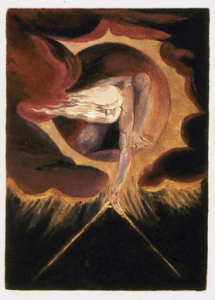
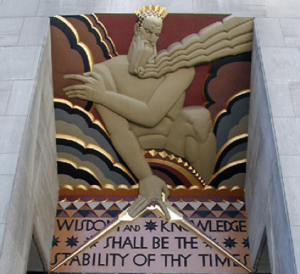

Europe, a Prophecy, copy B, object 1, 1794; Lee Lawrie’s “Wisdom” on the façade of the GE Building in New York City, 1933; Todd McFarlane, Urizen character in Spawn comic series, first appearance in 2000.
Arguably one of Blake’s most famous figures is Urizen. The figure’s depiction on the frontispiece of Europe, a Prophecy influenced Lee Lawrie’s 1933 figure of “Wisdom” on the GE Building in New York. More recently in 2000 Todd McFarlane quoted The First Book of Urizen in the bottom right of an illustration for his comic series Spawn in which a central god-like character is also named Urizen. Indeed, Blake himself depicts Urizen in a variety of forms across his illuminated books, and each appearance nuances this complex character who S. Foster Damon calls “the limiter of Energy, the lawmaker, and the avenging conscience” (A Blake Dictionary, 419). In the Europe frontispiece, the white-haired, nude Urizen crouches and bends forward to extend a pair or dividers or compasses into the black void below him. Such a representation underscores the figure’s role as world-creator and circumscriber. His energy, here in the form of sun-like rays, seems to emanate outward in all directions.
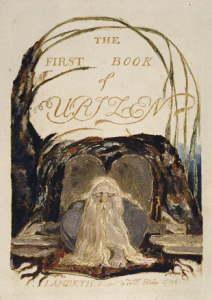
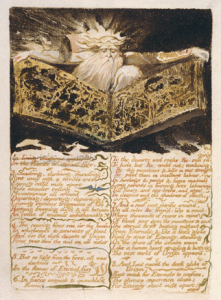
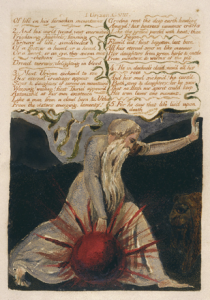
The First Book of Urizen, copy A, objects 1, 8, and 24, 1794
In contrast, the physical limitations of Urizen and his creation of the world are foregrounded in The First Book of Urizen. In objects 1, 8, and 24, he variously touches, holds, or carries objects associated with restrictive reason and law—respectively, tablets, a book, and a flaming sun perhaps indicative of enlightenment or the ability to see in the world. Morris Eaves has argued that the figure of Urizen in the title-page is represented as a man unable to stand erect in a universe of his own creating, becoming “a fleshy pistil of a huge stone flower with petals of geometric shape” (“The Title-Page of The Book of Urizen,” 225). Although the Urizen depicted in Europe similarly bends his head down, the connotations of this body position change drastically in the examples above from Urizen in which the downturned head and slumped body suggest the unrelenting tug of earthly gravity.

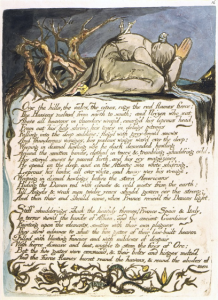
America a Prophecy, copy A, objects 10 and 18, 1795
Moreover, whereas Urizen is often depicted as an older male figure with a long beard, such as in object 10 of America a Prophecy, he has also been associated with figures who otherwise appear female. For example, in object 18 of America, copy A, the large figure who appears to pray with body contracted is identified in the illustration description as either a personification of Earth or Urizen. And the ambiguity here is not an aberration—it is unclear in many of Blake’s works whether figures with some of Urizen’s characteristic are intended to represent Urizen specifically. Thus, the specter of Urizen, the name that is often translated as “Your Reason,” leave its traces throughout Blake’s illuminated books.
